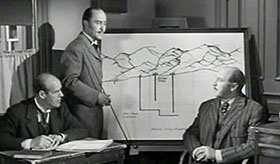





SOURCE REFERENCES
01. Maverick, War of the Silver Kings (1957), Warner Bros. Pictures, Inc.
02. The Conjectural Maverick, Maverick Trails
03. Parry, William T., All Veins, Lodes, and Ledges Throughout Their Entire Depth Geology and the Apex Law in Utah Mines (2004), The University of Utah Press
Silver Lady Mine
Silver mine owned by Phineas King in Echo Springs,[1] Utah Territory[2] in 1870.
In anticipation of the coming Union Pacific Railroad, entrepreneur and speculator Phineas King called on geologist and mining engineer William Fennelly in 1866 to survey sites along the proposed railroad route for potentially rich mineral deposits. In 1867, Fennelly found what King was after in Echo Springs.[2]
Based on Fennelly’s survey, King began buying up mines and land in Echo Springs, and staking new claims of his own under the name of the Silver Lady Mine. When the Union Pacific’s first locomotive passed through Echo Springs on January 16, 1869, King had already established himself as the principal land-owner and businessman of the mining camp.[2]
During the summer of 1870, Bret Maverick organized four smaller Echo Springs mines of Stoller, Jackson, Lawson and Kreidler, into the New Hope Mining Company to go into combined and aggressive competition with King’s Silver Lady Mine and establish labor reforms amongst the local mining community.[1]
Under Bret’s direction, the New Hope Mining Company began extracting rich silver ore from veins leading under Phineas King’s claim. Within two months of its creation, the combined mines saw profits of over $600,000.[1]
King fought the New Hope Mining Company in court, claiming that New Hope had no right to mine ore beneath his property. However, Bret invoked the Apex Law, an apparently outmoded, but unrepealed, provision of the Federal Mining Law of 1866[3] that allowed any
prospector to follow a surface outcropping, or apex, of a mineral vein on his claim downward wherever it leads, even if under the holdings of adjacent claims.[1]
Based on the merits of the Apex Law, Judge Joshua Thayer ruled in favor of the New Hope Mining Company, which was allowed to continue mining under the holdings of the Silver Lady. King immediately sought legal appeal from the territorial seat in Salt Lake City. While waiting for the decision of the higher court, King had his own mine flooded, which in turn flooded the New Hope tunnels next to his, effectively stopping all mining in Echo Springs.[1]
Knowing Thayer’s ruling would be overturned in the higher court, but allowing King to believe otherwise, Bret convinced King to merge the Silver Lady Mine with the New Hope Mining Company and retain all the reforms established by the latter. The ruling was indeed overturned in King’s favor, but not before their merger was settled, ensuring better wages and conditions for all miners in Echo Springs, and more eventual profit for King.[1] By 1878, however, the silver in Echo Springs played out and all mining operations, including the Silver Lady’s, were shut down.[2]
Diagram of mining tunnels of the Silver Lady Mine, surrounded by the diggings of the New Hope Mining Company in 1870.[1]

Home | The Maverick Saga | Trail Maps | Chronology | Maverick Lore | Production | The Inside Straight | Contact Maverick Trails
Maverick Trails is not endorsed, sponsored or affiliated with Warner Bros. Entertainment, Inc. or the Maverick franchise.
Maverick™ and its various marks are trademarks of Warner Bros. Entertainment, Inc., © 1957, 1994
©2014, 2015, 2016 Maverick Trails

